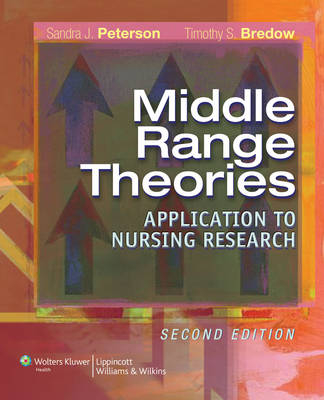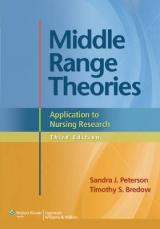
Middle-range Theories
Lippincott Williams and Wilkins (Verlag)
978-0-7817-8562-4 (ISBN)
- Titel erscheint in neuer Auflage
- Artikel merken
This groundbreaking text is the most complete and detailed book devoted to middle-range theories and their applications in clinical nursing research. The book thoroughly explains the process of selecting an appropriate theory for a particular nursing research study and sets forth criteria for critiquing theories. Each chapter includes examples of research using middle-range theories, definitions of key terms, analysis exercises, reference lists, and relevant Websites. Instruments are presented in appendices. New features of this edition include analysis questions for all theories; new chapters on learning theory and physiologic middle-range theories; "Part" introductions to frame the selection process for each middle-range theory chosen; and a glossary of terms.
Part I: OVERVIEW OF THEORY 1: Introduction to the Nature of Nursing Knowledge Introduction Nursing Knowledge Philosophy Paradigms and Metaparadigm Conceptual Models Theory: General Issues Grand Theory Middle Range Theory Practice Theory/Micro Theory/Situation-Specific Theory 2: Analysis, Evaluation, and Selection of a Middle Range Nursing Theory Introduction Historical Background Theory Analysis Theory Evaluation Selecting a Theory for Nursing Research Middle Range Theory Evaluation Process Part II: MIDDLE RANGE THEORIES: PHYSIOLOGICAL 3: Pain: A Balance between Analgesia and Side Effects Introduction Historical Background Definition of Theory Concepts Description of the Theory of Pain: A Balance Between Analgesia and Side Effects Applications of the Theory Instruments Used in Empirical Testing 4: Unpleasant Symptoms Historical Background Symptom Models Description of the Theory of Unpleasant Symptoms 5: Synergy Model Historical Background Description of the Theory of Synergy Model Use of the Theory in a System Part III: MIDDLE RANGE THEORIES: COGNITIVE 6: Self-efficacy Historical or Development Background Expanded Definitions of Theoretical Concepts Description of Theory: Major Components and Their Relationships Part IV: MIDDLE RANGE THEORIES: EMOTIONAL Historical Background Description of the Theory of Chronic Sorrow Applications of the Theory 7: Chronic Sorrow Historical Background Description of the Theory of Chronic Sorrow Applications of the Theory Part V: MIDDLE RANGE THEORIES: SOCIAL 8: Social Support Historical Background Definition of Theory Concepts Description of the Theory of Social Support 9: Caring Historical Background Definitions of Theory Concepts Description of the Theory of Caring 10: Interpersonal Relations Historical Background Definitions of Theory Concepts Description of Theory of Interpersonal Relations Part VI: MIDDLE RANGE THEORIES: INTEGRATIVE 11: Modeling-Role Modeling Historical Background Definition of Theory Concepts Description of the Theory of Modeling and Role-Modeling 12: Comfort Historical Background Definitions of Theory Concepts Description of Theory: Major Components and Their Relationships 13: Health-Related Quality of Life Historical Background Definition of Theory Concepts Description of the Theory of Quality of Life and Health-Related Quality of Life 14: Health Promotion Historical Background Pender's Definition of Health Description of the Health Promotion Model 15: Deliberative Nursing Process Historical Background Definition of Theory Concepts Description of the Theory of Deliberative Nursing Process 16: Resilience Historical Background Definition of Theory Concepts Description of Resilience: The Theory Appendix A: Critical Analysis Exercises Appendix B: Instruments Index
| Erscheint lt. Verlag | 1.3.2008 |
|---|---|
| Zusatzinfo | 22 |
| Verlagsort | Philadelphia |
| Sprache | englisch |
| Maße | 187 x 232 mm |
| Gewicht | 726 g |
| Themenwelt | Medizin / Pharmazie ► Pflege |
| ISBN-10 | 0-7817-8562-6 / 0781785626 |
| ISBN-13 | 978-0-7817-8562-4 / 9780781785624 |
| Zustand | Neuware |
| Haben Sie eine Frage zum Produkt? |
aus dem Bereich



